Tomb of the Unknown Soldier – the memory of the fallen endures
Almost every country has a monument to unknown soldiers who fell in war. The idea of paying tribute to the nameless took shape after the tragedy of the First World War – the Great War – during which millions died and many were never identified.
The world’s first monuments honouring unknown soldiers were unveiled in the United Kingdom and France on 11 November 1920. The Paris monument has a particular history. It was proposed by François Simon, a French social activist, who lost three sons at the front in the First World War. He never succeeded in tracing their remains, and his determination to honour the unknown soldiers found expression in the following words:
‘Why does France not open the doors of the Panthéon to one of its unknown soldiers who fell heroically for the Fatherland? […] Placing the remains of an ordinary soldier in the Panthéon, where so many geniuses lie, would be a symbol and also a tribute to the entire French army.’
The idea won considerable public support, and the French parliament passed an act to commemorate unknown soldiers. It was decided that the remains of a single fallen soldier would be laid beneath the Arc de Triomphe on 11 November 1920.
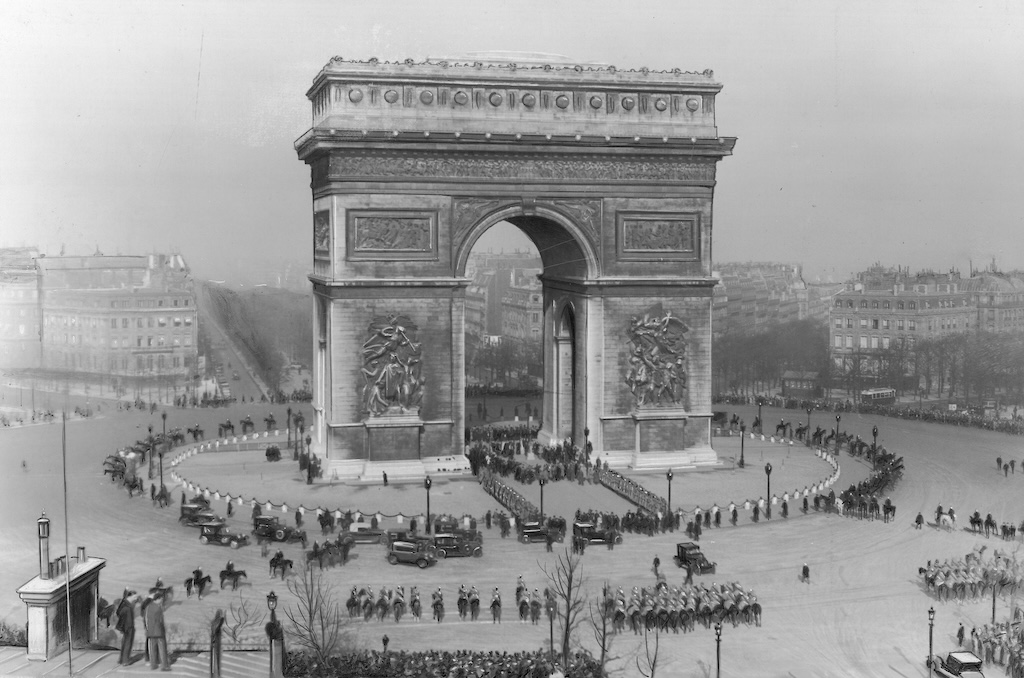
Tomb of the Unknown Soldier - yes but where?
The idea of honouring unknown soldiers quickly found favour in Poland, which had just regained independence. In the autumn of 1920, at the intersection of Nowy Świat Street and 3 Maja Avenue in Warsaw, a temporary monument was erected – a sarcophagus topped with an eagle and bearing the inscription: ‘To those fallen for the Fatherland’. This was one of the first initiatives to commemorate those who fell in the country’s struggle for independence. Soon, the Committee for the Commemoration of the Fallen 1914–1920 was set up, under the leadership of the Chairman of the City Council, Ignacy Baliński. A design was prepared for an urn‑shaped monument in the Cathedral of St John the Baptist, by Stefan Szyller. However, the funds required to complete the project were never raised. At the same time, the ‘Polish Mourning Cross’ Association, led by General Juliusz Tarnawa‑Malczewski, proposed that a monument be erected in Skaryszewski Park. This idea, supported by the daily newspaper ‘Polska Zbrojna’, attracted considerable public interest. Other proposals were also put forward, including locating the monument at the Citadel. None of these, however, came to fruition.
By order of the President of the Republic of Poland, Stanisław Wojciechowski, on 30 November 1923 the Minister of Military Affairs, Lieutenant General Stanisław Szeptycki, appointed the Temporary Organising Committee for the Construction of the Monument to the Unknown Soldier. General guidelines were soon announced – the monument was to commemorate those who fell in both the Great War and the national uprisings from 1794 onwards. It was stipulated that it should have ‘a triumphant and joyful character – not a tomb, but rather a monument of glory with an architectural form’. Progress then stalled; although the monument was to be funded by public subscription, the Committee’s lack of concrete action dashed hopes of swift completion.
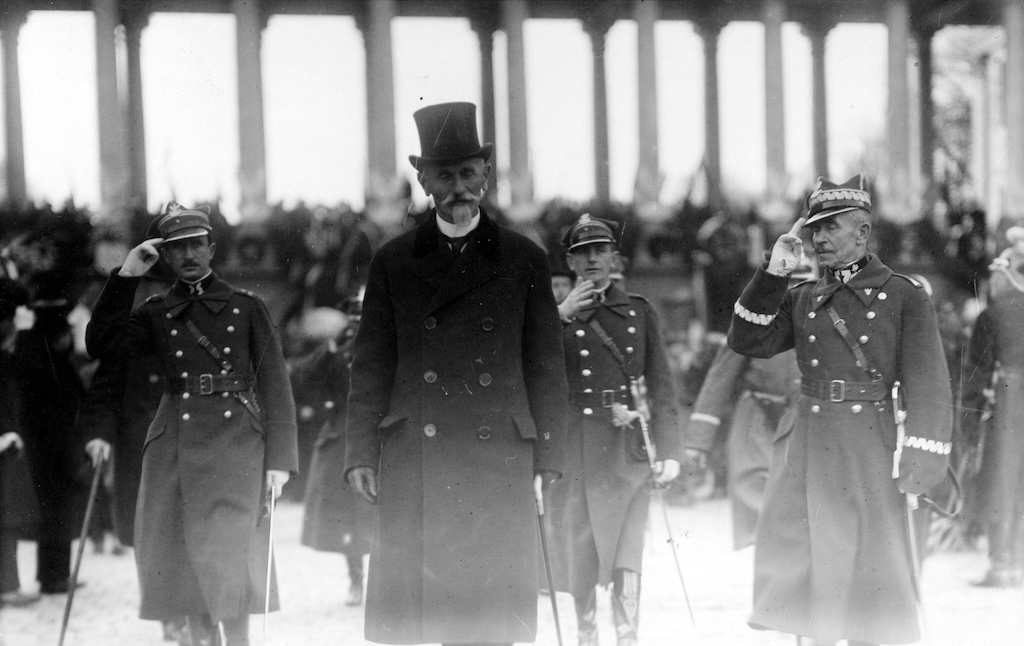
An unexpected turn of events
The Committee resumed work only a year after its establishment, and then only after a mysterious event. On the morning of 2 December 1924, a sandstone slab appeared on Saxon Square, in front of the monument to Prince Józef Poniatowski, bearing the inscription: ‘To the Unknown Soldier who fell for the Fatherland’. Three days later, an urn with a flame was placed beside it. The public approved, laying flowers at the slab and lighting candles. What remained a mystery, however, was who had initiated and funded the slab. At first, the initiative was attributed to Ignacy Jan Paderewski. Light‑hearted verses appeared in the press – one suggested that the slab had been placed by the prince himself:
Warsaw – and with her, all of Poland – asks anew:
‘Whence came this stone slab at the soldier’s view?
Who laid it here upon the Unknown Soldier’s grave?’
One says this, another whispers what they crave…
(...)
‘To stir your hearts, so cold and unaware,
And so the Unknown Soldier – long in despair –
May have at last the grave he’s sought full four years
I bring this stone from the depths of Elster’s!’
It was only four years later that it emerged that the plaque had been created thanks to the ‘Union of Polish Associations of the Republic’, and that its sponsors were the president of the organisation, Count Adam Zamoyski – owner of the stonemasonry works where the slab was made – together with Count Roman Lubowiecki and the social activist and industrialist Emil Rauer.
As this grassroots initiative to place a plaque on Saxon Square in memory of the fallen met with the approval of Warsaw residents, the location of the monument came to be regarded as having been chosen by the public. It also had the support of President Stanisław Wojciechowski, and on 25 January 1925 – at the request of the Minister of Military Affairs, Lieutenant General Władysław Sikorski – the Council of Ministers resolved that the Tomb of the Unknown Soldier would be sited in the colonnade of the Saski Palace (also Saxon Palace). The Council also selected the monument’s designer – the sculptor Stanisław Ostrowski.
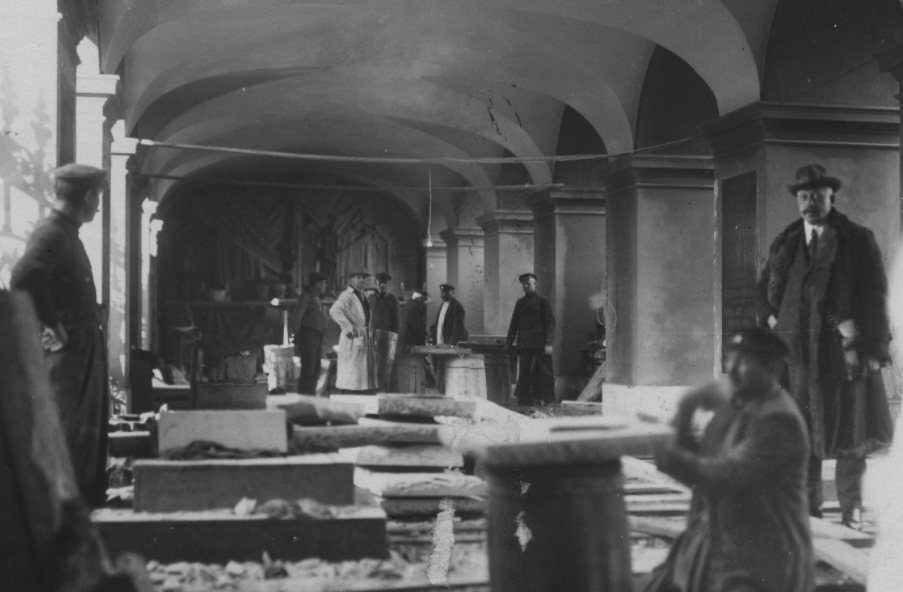
The project
The designer of the Tomb of the Unknown Soldier had to address not only the task of conveying the complex symbolism of his design, but also the challenge of integrating it with the square’s urban layout, while maintaining a passage between the square and the Saxon Garden and ensuring access during official ceremonies. Criticism persisted over the impact on the palace’s historic character and on circulation between the square and the Garden. In response, in March 1925, Stanisław Ostrowski presented a full‑scale (1:1) mock‑up of the monument. Representatives of the Ministry of Military Affairs, the Ministry of Religious Denominations and Public Enlightenment, and the Warsaw authorities attended the viewing. The final design of the monument was approved on 14 May 1925, and construction began.
The construction
The construction of the Tomb of the Unknown Soldier was undoubtedly Stanisław Ostrowski’s crowning achievement. He was assisted by his daughter Halina, a student at the Warsaw Academy of Fine Arts, who undertook research into its symbolism and military history. The team working on the monument also included stonemasons under the supervision of the engineer Stanisław Wyczałkowski. Meanwhile, Ludwik Gardowski, a professor of lettering and printing at the Warsaw Academy of Fine Arts, was commissioned to design the tombstone proper.
The feverish atmosphere of the final days of work on the monument was described in her diary by Halina Ostrowska Grabska: The inscription on the gravestone, provided to her father and the press by the Historical Bureau of the Ministry of Military Affairs in July 1925, read: ‘To the Unknown Polish Soldier who fell for the Fatherland’. […] When the design was ready and handed over to the stonemasons for carving, out of the blue, on 28 October, a change to the text was announced – unquestionably for the better, but one that completely upset the previous layout and composition of the plaque. […] Ludwik Gardowski therefore hastily sketched a second design, took me, his student, to assist him, and we spent the entire night from 28 to 29 October working on a full‑size (1:1) layout. On the floor of the small lounge on Brzozowa Street […], a plywood board was laid out. […] Kneeling and lying on the floor – Gardowski at the top of the slab, me at the bottom – we traced the inscription on cardboard and carbon paper: ‘Here lies a Polish Soldier who fell for the Fatherland’. […] Her father, meanwhile, was concerned about whether we would be able to finish the inscription by morning – every hour was precious, as the stonemasons had only three days left to complete it and – always allowing for the possibility of a mishap, a chip while chiselling a letter – the deadline was dangerously short. […] We managed to finish both required copies of the inscription in time, trembling only at the thought of whether the stonemasons, to whom the inscription had already been delivered, would make it in time and manage to complete the slab without a hitch in such haste.
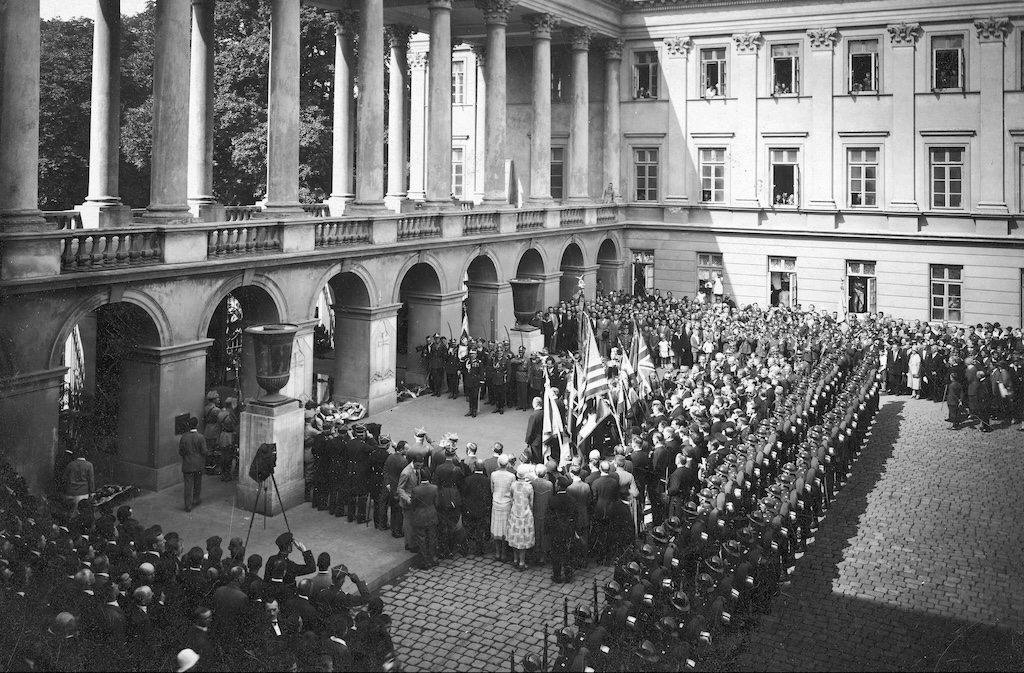
The Tomb of the Unknown Soldier, designed by Stanisław Ostrowski, was a project that combined the existing architectural fabric with new elements of striking symbolism. The monument comprised several elements. The centrepiece was the tomb itself, in which the remains of the Unknown Soldier were interred – a 1.5‑metre‑deep steel crypt, sealed with a grey‑sandstone slab bearing the inscription: ‘Here lies a Polish Soldier who fell for the Fatherland’.
Behind the slab burns a flame in a semicircular bowl, supported by three figures of Nike, their arms crossed across their chests. A fresco of a laurel wreath was painted on the vault above the tomb. Along the vaults of the arcade, on either side of the slab, metal lanterns with winged motifs were hung.
Metal details
The three central bays of the arcade were enclosed by cast‑iron railings running between stone piers topped with cannonballs, recalling old artillery shot. On the garden side, three decorative grilles were installed to complement the setting – the Saxon Garden. The grilles were decorated as follows: the central one bore the Polish military eagle, surmounted by a gold crown; the left, the Virtuti Militari Cross; and the right, the Cross of Valour.
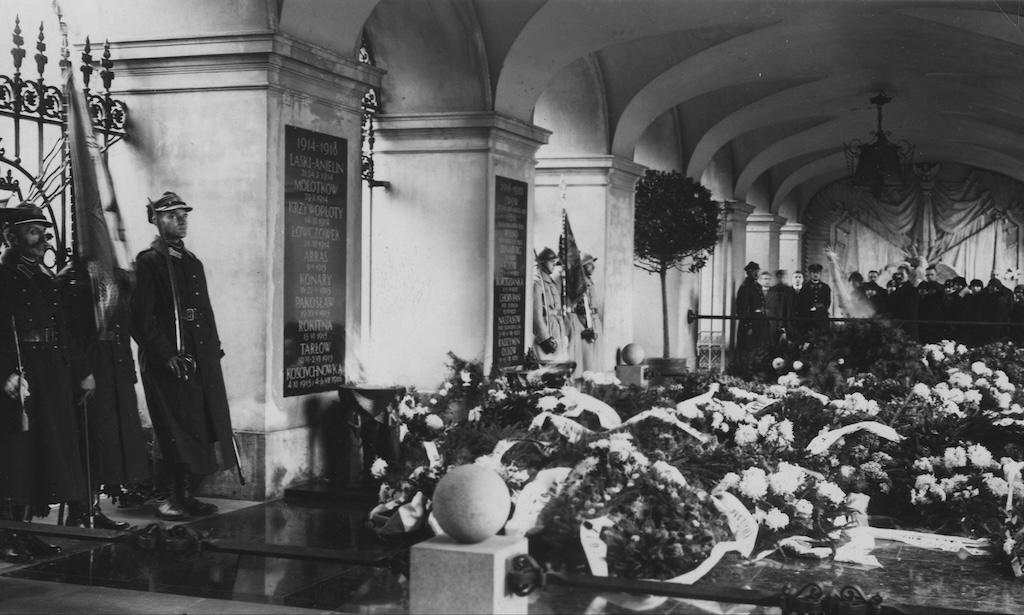
On the inner sides of the pillars were granite plaques listing selected battlefields on which Polish troops fought from 1914–1920 and from 1918–1920. Beneath each plaque burned a flame in a bowl supported by three figures of Nike (similar to the flame behind the tomb slab).
Stone decoration
The monument was flanked by two trophy‑style bas‑reliefs mounted on the side walls of the Saski Palace beneath the arcades. On the south wall, they represented the battles of the uprisings; on the north wall, those fought by the Polish Army in the struggle for independence. Both reliefs shared a similar composition: banners with sharply defined folds were arranged almost horizontally at the bottom, becoming more vertical higher up. The lower part of the bas‑reliefs depicted cannonballs; above them, two cannon barrels, on which an eagle with outstretched wings was perched (on the south wall, the wings were spread wider); a second eagle capped the composition at the top, while hussar wings framed it on the sides. Outside, the monument was encircled by five stone pedestals, each bearing a bronze urn in the Classical style, decorated with a frieze depicting a mourning procession of female figures carrying torches. On state occasions, gas flames burned in the urns, creating a striking play of light. On the piers of the arcade — on both the square and garden sides — are bas-reliefs depicting Jagiellonian swords flanked by hussar wings. This is the only element of the original design to have survived to the present day.
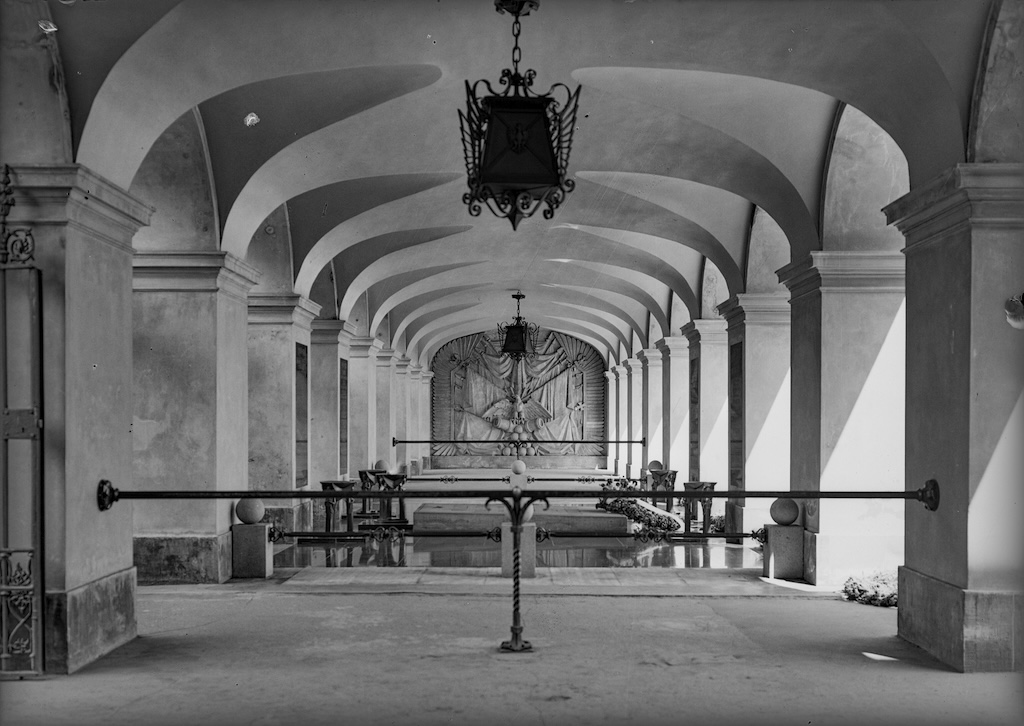
This is how the ‘Polska Zbrojna’ magazine reported the reaction to the unveiling: ‘The mausoleum, so successfully resolved architecturally and built under the direction of the sculptor Stanisław Ostrowski, won particular acclaim among diplomats and foreign military attachés, who regard Poland’s Tomb of the Unknown Soldier as one of the most beautiful in Europe and did not conceal their admiration at yesterday’s ceremony.’ [...] ‘The mausoleum is truly beautiful in its noble simplicity and modesty. […] The Sarcophagus of Glory, built on Saxon Square, is no makeshift; it is a permanent memorial that should be revered and cared for by the entire nation.’
Tomb of the Unknown Soldier in ruins
The Tomb of the Unknown Soldier was destroyed in the final days of December 1944, when the Saski Palace was blown up. Only the central bay of the arcade survived; its vault collapsed inwards, shattering the slab. All flames were extinguished, and the grilles were twisted out of shape. The first post‑war honour guard was mounted at the surviving fragments of the Tomb of the Unknown Soldier on 17 January 1945.
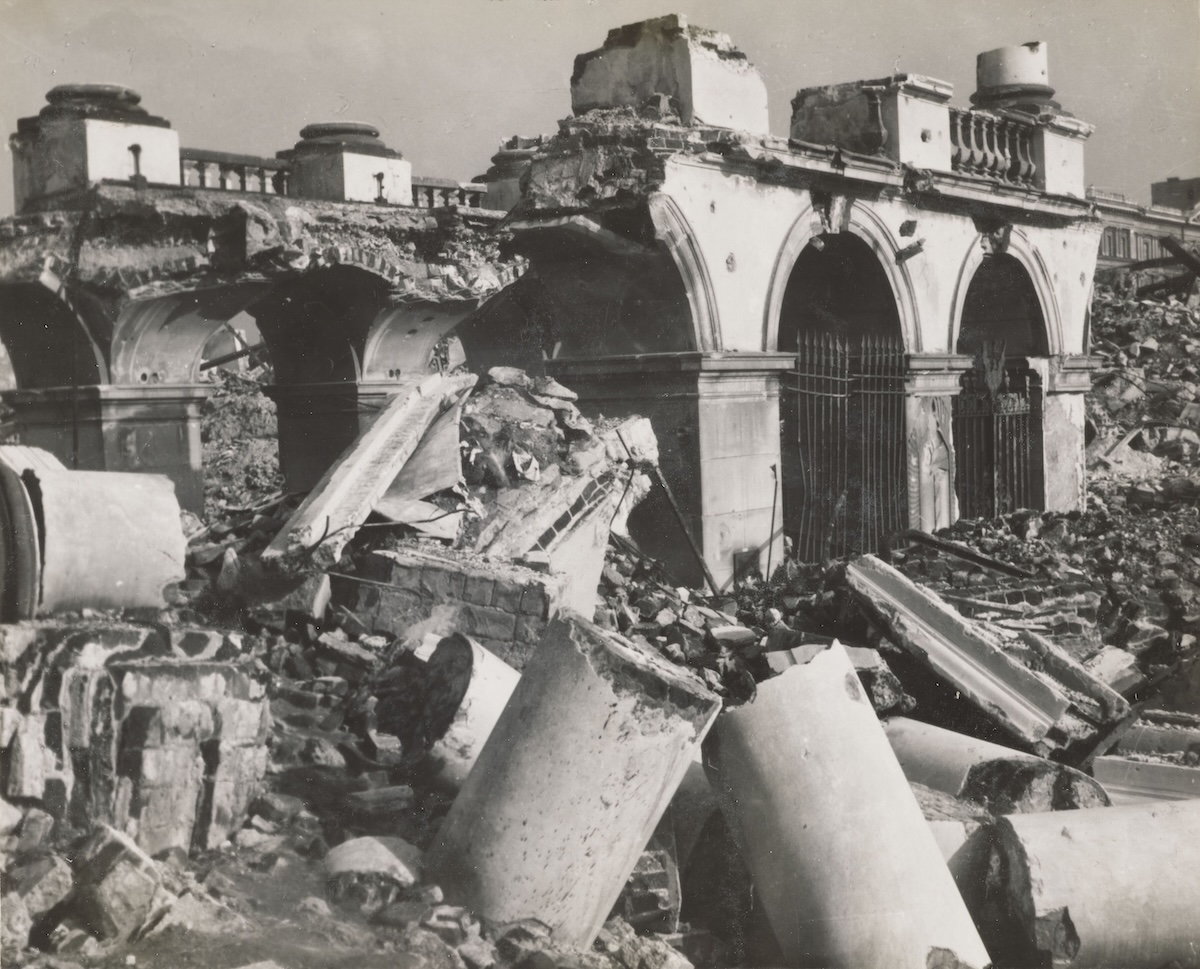
Author: Maria Wardzyńska
The article was published in "Stolica" magazine 11-12, November-December 2022